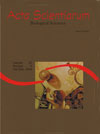<b>Feeding of <em>Rhinodoras dorbignyi</em> (Kröyer, 1855) (Siluriformes:Doradidae) in the Ibicuí river, Rio Grande do Sul State, Brazil</b> - DOI: 10.4025/actascibiolsci.v29i2.446
Abstract
The study of the feeding ecology of Rhinodoras dorbignyi was conducted in three sites of the Ibicuí river, Rio Grande do Sul, Brazil, from December 1999 to January, 2003. The specimens were sampled bimonthly. The feeding spectrum was determined combining the frequency of the occurrence with the volume of each alimentary item, in order to obtain the feeding index (IAi). The spatial analysis was based on the diet and distribution of R. dorbignyi in the three sampling points, and also in their different biotopes. Temporal changes on diet and capture of the specimens were evaluated considering the seasons and the daily feeding rhythm. The intensity of spatial-temporal feeding intake was analyzed using the average stomach fullness. Significance level of 0.05 was used in the analyses. Ephemeroptera nymphs belonging to the family Polymitarcyidae represented the main feeding item (62.48%). The feeding spectrum of R. dorbignyi showed significant differences regarding sampling points, seasons, and biotopes. The species showed highest abundance in lotic environments, during the spring and summer and after sunset. No statistically significant results were observed with regard to spatial and temporal differences in feeding intake.Downloads
Download data is not yet available.
Published
2007-12-05
How to Cite
Fagundes, C. K., Behr, E. R., & Kotzian, C. B. (2007). <b>Feeding of <em>Rhinodoras dorbignyi</em> (Kröyer, 1855) (Siluriformes:Doradidae) in the Ibicuí river, Rio Grande do Sul State, Brazil</b> - DOI: 10.4025/actascibiolsci.v29i2.446. Acta Scientiarum. Biological Sciences, 29(2), 137-143. https://doi.org/10.4025/actascibiolsci.v29i2.446
Issue
Section
Ecology and Limnology
DECLARATION OF ORIGINALITY AND COPYRIGHTS
I Declare that current article is original and has not been submitted for publication, in part or in whole, to any other national or international journal.
The copyrights belong exclusively to the authors. Published content is licensed under Creative Commons Attribution 4.0 (CC BY 4.0) guidelines, which allows sharing (copy and distribution of the material in any medium or format) and adaptation (remix, transform, and build upon the material) for any purpose, even commercially, under the terms of attribution.
Read this link for further information on how to use CC BY 4.0 properly.
0.6
2019CiteScore
31st percentile
Powered by 

0.6
2019CiteScore
31st percentile
Powered by 











1.png)




3.png)













